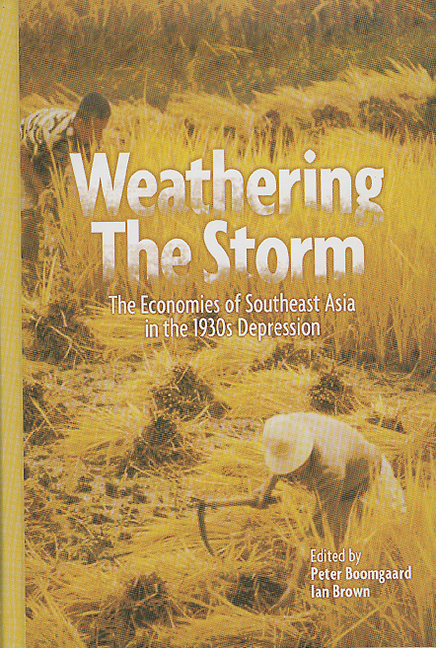Book contents
- Frontmatter
- Contents
- List of Tables
- List of Figures
- Acknowledgements
- List of Contributors
- 1 The Economies of Southeast Asia in the 1930s Depression: An Introduction
- PART I MATERIAL CONDITIONS
- 2 Surviving the Slump: Developments in Real Income During the Depression of the 1930s in Indonesia, Particularly Java
- 3 The Philippines in the Great Depression: A Geography of Pain
- 4 Uneven Impact and Regional Responses: The Philippines in the 1930s Depression
- 5 Material Conditions in Rural Lower Burma During the Economic Crisis of the Early 1930s: What the Cotton Textile Import Figures Reveal
- PART II AGRICULTURAL STRATEGIES
- PART III TRADING COMMUNITIES
- PART IV THE STATE'S RESPONSE
- Index
2 - Surviving the Slump: Developments in Real Income During the Depression of the 1930s in Indonesia, Particularly Java
from PART I - MATERIAL CONDITIONS
Published online by Cambridge University Press: 21 October 2015
- Frontmatter
- Contents
- List of Tables
- List of Figures
- Acknowledgements
- List of Contributors
- 1 The Economies of Southeast Asia in the 1930s Depression: An Introduction
- PART I MATERIAL CONDITIONS
- 2 Surviving the Slump: Developments in Real Income During the Depression of the 1930s in Indonesia, Particularly Java
- 3 The Philippines in the Great Depression: A Geography of Pain
- 4 Uneven Impact and Regional Responses: The Philippines in the 1930s Depression
- 5 Material Conditions in Rural Lower Burma During the Economic Crisis of the Early 1930s: What the Cotton Textile Import Figures Reveal
- PART II AGRICULTURAL STRATEGIES
- PART III TRADING COMMUNITIES
- PART IV THE STATE'S RESPONSE
- Index
Summary
INTRODUCTION
In the second half of 1997 and the first half of 1998, Indonesia went through a particularly difficult period. During the summer and autumn of 1997 the country had been faced with widespread forest fires and harvest failures due to severe drought. While this was going on, the financial crisis in Thailand triggered off devaluations in the Philippines, Malaysia, and Indonesia in July 1997. Indonesia was hit again in January 1998, when the rupiah found itself in free fall, foreign capital-owners withdrew their portfolio investments, and real or imagined price rises led to rural and urban unrest. The Year of the Tiger was off to a very bad start.
Whatever the ultimate outcome of these recent developments, already called the worst economic crisis in Indonesia since 1966, they do remind us of that other, much more (in)famous crisis, now almost seventy years ago. That in itself is good reason for a (re)study of the 1929 crisis and the depression of the 1930s. To my mind, it would be particularly promising to take a closer look at developments in the standard of living during those years, as this is still a topic of considerable controversy, or rather a topic on which people hold widely diverging opinions.
This has been so since the late 1930s, when the first accounts of the depression in the Indies were written. On the one hand there are the ‘pessimists’, according to whom the depression was an appalling disaster for the Indonesian population. The economist G. Gonggrijp, writer of an economic history of Indonesia, is an early representative of this school. More recent adherents to the pessimist school are J. A. A. van Doorn, William O'Malley, and W. F. Wertheim. I am somewhat hesitant to class D. H. Burger with the pessimists, but he certainly does not belong to the optimist school. In the late 1950s, he wrote a social and economic history of Indonesia, that was not published until 1975.
- Type
- Chapter
- Information
- Weathering the StormThe Economies of Southeast Asia in the 1930s Depression, pp. 23 - 52Publisher: ISEAS–Yusof Ishak InstitutePrint publication year: 2001



